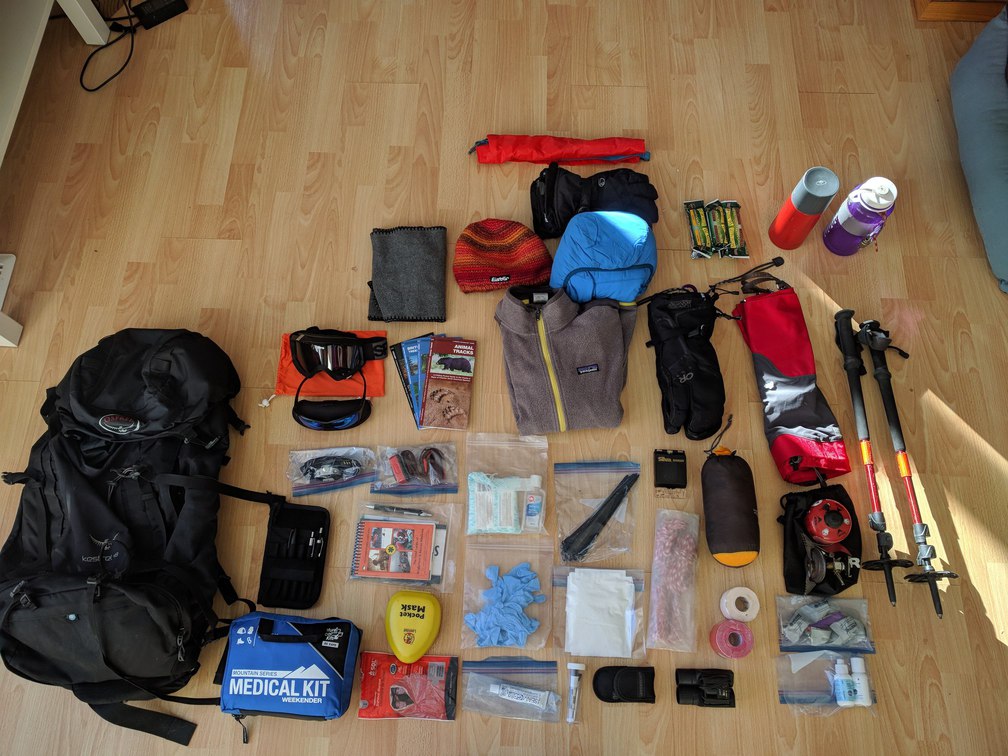What's in a Guides Pack?
One of the things that I hear a lot when guiding is the question why my pack is so big and heavy. Which is particularly funny when I'm doing a Johnston Canyon Icewalk where some of the guest join me without any snacks, water or day pack for a three hour hike. But that's a different story 😇.
Let me get back to the topic that I actually want to talk about though: the content of my pack. I'll walk you through the entire content but to start off I'll give you an idea of what my disassembled pack looks like:

First Aid
One of the most important pieces is obviously the first aid kit. I'm using the Adventure Medical Kits - Weekender because it comes with a good basic selection of medical supplies but also has some extra room to add some additional medical and athletes tape. I'm also able to fit my C-Splint in there which means it's all in one place.
The only thing that I keep separate and in the top of my pack rather than the bottom is the CPR Pocket Mask. I prefer carrying a proper mask with a one-way valve instead of using the plastic sheet included in the first aid kit. Using the pocket mask correctly in an emergency is a lot more likely than with the face shield.
I also carry a bunch of Latex-free medical gloves that are not only useful in emergencies involving blood but also for picking up questionable garbage along the way. Yes, I'm very dedicated to Leave No Trace. I also carry an emergency blanket that'll help prevent hypothermia in a patient.
Last but not least, I carry a CPGear Tactical Field Notebook my SOAP notes and a first aid cheat sheet. They are my support system and the reporting tool for any serious incident that might occur during a trip.
Keeping Things Clean
Now that we have emergency treatment covered, I also carry a ZipLock bag with toilet paper. Not necessarily a thing that you'll need for a two hour hike with a washroom at the trailhead but definitely essential for any longer trip. An additional ZipLock bag serves as a garbage can specifically for the used toilet paper. Yes, we carry that out too, so we leave no trace.
Handling your own waste is the main reason for medical issues such as diarrhea which makes it essential to always wash your hands. For that reason I keep a small bottle of hand sanitizer and a packet of wet wipes.
Don't despair, Repair
There are two things that I never leave without: Zip Ties and Duct Tape. Although I never carry an entire roll of tape with me. I wrap some of it around my hiking poles and my Nalgene water bottle.
I've also learned that hiking boots aren't forever and that it's not a bad idea to keep some SeamGrip and Super Glue handy for those occasions. I actually have an interesting story about that.
Avoiding Thirst
Keeping myself and my clients hidrated, especially in an emergency situation, can be more difficult than you think when you run out of water. Many streams here in Canada can carry Giardiasis and I don't recommend drinking untreated water when guiding. I therefore have water purification drops that will make water drinkable within about 15 minutes.
As a backup, I always have my MSR stove with me and a small gas cartridge as well as some fire starters and a lighter. Boiling water can take longer than the drops but having some redundancy in water treatment department is never a bad thing. And the fire starters will help to get a fire going for warmth as well.
I do usually carry between two and three liters (!) of water with me on a day hike. That might seem ridiculous but in addition to my own needs, I also have to be prepared for some of my clients running out or not bringing enough in the first place.
Just In Case Items
The rest of my pack is filled with a couple of extra layers. A fleece, my Patagonia Nano Air and in the winter an extra toque, gloves and a scarf. I also always keep a pair of rain pants close regardless of the season.
I don't usually use my hiking poles but I always bring them in case a client requires them. They do come in handy for building an emergency shelter as well if it so happens that we have to spend the night.
Some ropes and a tarp can be useful not just in emergencies but when the weather gets a bit rough. A dry lunch spot can improve the general atmosphere in a group after walking for a while in the pouring rain.
Sunglasses, googles and some headlamps ensure that whatever happens, I'll be able to have a clear view. Running late on a day trip is not unheard of and having some lights to take away the darkness can prevent injuries...and fear.
And I pack all of this into...
...my Osprey Kestrel. It's an amazing backpack that has a lot of space but also packs down pretty small if you just go for a day hike. Nowadays, I usually use it for everything. Packing a few extra layers and some rain gear is never a bad idea and the Osprey just swallows it up.
Here you go, now you know what I carry in my pack and why I look like I'm going on a five day mission whenever I take my clients on a two hour hike 😉.